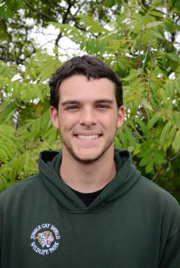Speaking to scientists: Kristyn Ferguson
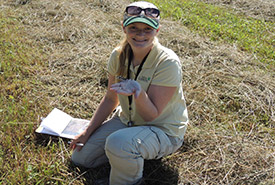
Kristyn Ferguson, program director, Georgian-Bay Huronia (Photo by Mike McGahon).
We at Earth Unfiltered were very lucky to have a conversation with Kristyn Ferguson, a program director from the Nature Conservancy of Canada (NCC). Kristyn is a Toronto-born nature lover who completed her bachelor's degree in environmental science at the University of Guelph. She has continued to work with the NCC across Ontario and is now living out her dream as the program director in the Georgian Bay/Huronia sub-region. Her candidness and passion for nature, poetry and birding make her a joy to talk to, and she has fantastic insights regarding Ontario’s conservation initiatives.
Earth | Unfiltered (EU): What, exactly, does it mean to be a program director at the NCC?
Kristyn Ferguson (KF):There are six sub-regions across Ontario, and at the head of each is the program director, who’s in charge of land securement. So, actually doing property deals, accepting donations and purchases of land, as well as overseeing the stewardship program — taking care of the properties that we’ve acquired — and typically we have staff working for us who lead the stewardship work, so the on-the-ground field work, but I’m lucky in that I get to do a little bit of that myself. Field work is wonderful; it’s lots of fun! There are also fundraising responsibilities with this job, raising money for the projects we want to complete.
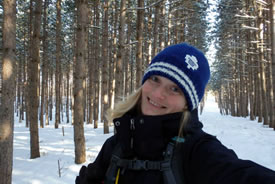
Kristyn Ferguson out for a snowy day of field work (Photo by NCC)
EU: What are some of the most important conservation goals in the Georgian Bay area?
KF: Working on securing high-priority pieces of land in my priority natural areas. I’m really focused on the Carden Alvar, which is just northeast of Lake Simcoe; the Minesing Wetlands, which are about 10 minutes west of Barrie; and the Eastern Georgian Bay Coast, which is actually where I’m heading tomorrow.
So, working in those areas, they’re already very well protected, but it’s about acquiring those last parcels that are still in private ownership, which have fantastic natural features on them.
EU: How long have you been working in the Georgian Bay area?
KF: I’ve been the program director since July 2012, so four years.
EU: Have you seen any changes in the area?
KF: Yes, definitely. The rate of cottage development continues to expand throughout the region, and it’s also a place where we’re starting to deal with significant invasions of non-native species, such as dog strangling vine and phragmites that weren’t an issue maybe five years ago.
EU: What is phragmites?
KF: You know it, even if you don’t know you know it. It’s that big tall grass that grows along the sides of Highway 401 and other major transportation corridors throughout southern Ontario. It is nasty when it gets into wetlands and it can completely take over natural habitats.
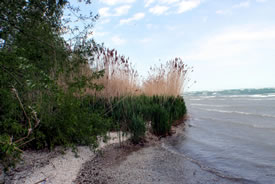
Invasive non-native phragmites on Pelee Island (Photo by NCC)
EU: Since you grew up in Toronto, do you have early memories of being in nature?
KF: Yeah, and it was because my parents did a great job of getting me out to nature, so we hiked, and every summer we’d camp at Killbear Provincial Park.
EU: Besides your parents, was there any person or thing that kind of connected you to the idea of nature and getting out there?
KF: I was just thinking about it before this call, and what I could really place, aside from those early camping experiences, was when my parents popped me in a day camp that, I think, was just north of Toronto. It was a nature camp and these two weeks, just being in nature — you know, we had our hands in clay down by the river, and we were walking through forests and playing those hilarious survival games — and just some of the feelings of being in the river, in the forest, they’re really tangible for me, and I just...I felt right, somehow.
EU: Was there someone or some moment when you realized that you could make a career out of working in nature?
KF: Yeah, it was during my undergrad. I was doing environmental biology, I was in my third year, and I was in a class called Problem Solving in Environmental Biology. And the problem I wanted to solve was saving this really neat place I’d read about online called the Happy Valley Forest. In my research I learned about NCC and what they were doing, which was actually buying pieces of land in Happy Valley Forest to keep it the way it was, forever. This is a forest that’s just North of Toronto, sort of the King City area. And I remember thinking to myself, “You can do that as a job?” And then it became my dream job.
EU: And you’re there!
KF: I know! I got very lucky.
EU: Did anyone ever tell you that you were crazy for getting into this line of work?
KF: No, people have said, “That sounds amazing,” “You get to go outside for your job!" and “That must feel good at the end of the day” and all of those things are true. It’s pretty awesome!
EU: Is there a best and worst, a peak and a pit, of what you do?
KF: I really love the high that comes with the successful securement of a piece of land. The feeling I get when a land deal has closed, and I walk on to it for the first time, and I know we own this and it’s never going to change — that is just such a high. I have selfies of me on a couple of properties for the first time, looking very excited.
But then the challenge that goes along with everything we do here, is this perpetual seeking of funding. Everything we do needs money to support it, and the people to do the work, so we’ve got to pay those people and find the funds. So it’s sort of an — I don’t want to say a hamster wheel — it’s just sort of the perpetual chasing of funds, and once you secure some funds and think “This is so great, this person is going to give us a nice big grant!”, it’s almost time to start looking for the next one, to support the next bit of work you have to do.
It can be challenging, but there’s a lot of excitement that comes with that too, especially when you meet a donor who’s got the same interests as you, and you can get them excited about something you’re excited about. We have an amazing fundraising department here, so I do some of it on my own, but I’m always supported — having leads pulled and talking points prepared — by this great team of about six employees we’ve got here that just really focus on fundraising.
EU: There’s kind of this reputation that science people are really good with people skills. Do you find it is very important for scientists to have good interpersonal skills to get things done?
KF: Yeah. It’s really that link between realizing what needs to be done and how to do it, and then finding the people who are going to support your work whether it be through volunteering, or providing donations, or telling their friends about the great things you’re doing. The communication aspect is the link between those two things. So if you’re able to walk both sides of that, and be a scientist who can talk to people and sell what we’re doing every day, that makes your life a lot easier, for sure.
EU: Speaking of communication, when did you start writing poetry about nature?
KF: After all I’ve said about the environment, I was a writer first and foremost for most of my life, up until I was about 18. I was sure that I was going to be a writer as my career path. And then I got told by my mom and a career counsellor that I might want to pick something a little more solid to study in school. They said, “You can do math and science, why don’t you pick a type of science?” and environmental science was an obvious pick for me.
But I never have let go of this dream of writing, and I’m just always writing. Whether it’s just reflections or poetry or this novel I’ve been working on for, possibly, close to a million years — it’s not even close to done — writing’s just always there. Then last winter at NCC’s staff rally in January, I met Lorna Crozier — and if you haven’t read her poems you have to Google her, she’s just amazing — and she read some poems to us.
And I sat with her at dinner one night, and I told her I just loved her nature poetry, and what advice would she have for me, and she said “just write.” So I started my blog shortly after meeting Lorna, and even shared my first poem that I published on there with her, and she liked it a lot, and that made my day. So I’m really trying to keep up with writing poetry.
Any time I get inspired by nature — and it just happens, there are just moments that get caught in my head, and they look like poems — then it’s a question of turning them into poems whenever I get around to sitting down and writing it all down.
EU: I know you’re a very avid birder. As an avid birder, do you have your [life] list?
KF: Yes I do, but not with me.
EU: Do you have an estimate of how many species you’ve seen?
KF: Oh…I really don’t. I know it would be at least in the couple hundred range. Maybe more. I have maybe lost count. Every time I get back from a trip, I scribble down on scrap pieces of paper here and there all the cool species I saw, so my list is a little bit disorganized at the moment. It’s all over the place. I think the rarest bird I’ve seen — that I’ve had the pleasure of seeing — is the loggerhead shrike, in Carden Alvar right here in Ontario. That’s the last stronghold for their population. Every time I see a shrike, it’s a good day. On my trip to Iceland this summer, I got to see nesting puffins up close on a sea cliff and that was pretty unreal.
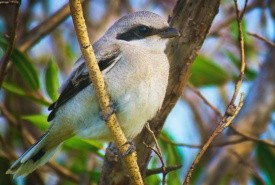
Loggerhead shrike (Photo by Don and Karol Dabbs)
EU: How do you feel about people being obsessed with Pokemon Go, when really it’s just birding, but virtual?
KF: That’s really funny you said that, because you’re right. It’s sort of the gamefication of nature/birding, isn’t it? Once, I looked down a famous birding road in Carden Alvar and saw all these people, binoculars up, so excited, talking to their friends, giving tips, and I went, “It’s just like a video game without the video element,” and it’s so true. Whatever it takes to get people outside and excited about looking for things, I think that could all translate.
EU: I’m obsessed with people who bird, I’m not obsessed with birding, but I am with people who bird. What would you say to the haters of birding who claim it’s a waste of time?
KF: In addition to being incredibly fun, it’s providing citizen science information. So, if you can’t sell them on how awesome it is, it’s really about what you’re doing by birding. Anytime you’re participating in a Christmas bird count, or I do the Carden Challenge — a 24-hour birding challenge every spring — you’re gathering information on these species and their population trends, and so if something’s missing, that’s a big deal. Or if something showed up, maybe it’s an indicator of climate change, or it shows that the conservation you’re doing in an area is working. The information you’re collecting, it’s not just for fun, it definitely is a form of science!
EU: Have you found that there’s a hierarchy of birders within the community?
KF: Yeah, that’s a good observation, it’s true. I can definitely recognize a few of the big birding names in platforms like Ontario Birds, and it’s a big deal when this person’s posting; and I’m subscribed to a regional birding listserv, so if this guy’s seen something, you know it’s legit and you don’t question it, and you think, “How did he find that? He’s amazing!” Then there are the rest of us, who’re aspiring — maybe not to get all the way there — but yeah, for sure. I’m lucky to be pals with a couple of really, really good birders, who I got to know through the Christmas bird counts in Guelph. They’re a teeny bit famous, so it makes me feel famous when I’m next to them.
EU: I love that so much!
KF: It’s “birding famous,” so it’s all relative.
EU: Getting back to conservation/environmentalism side of things, there’s often a perceived generational divide. What would you want people older and younger than you to know about environmentalism and conservation?
KF: I don’t think there’s any bad information that can be shared. I would just recommend that everybody stay as up to date with the latest research and even with the latest news coming out of your [local] conservation organizations. Whether it be in their printed mailings, which might be suitable for older generations — not to stereotype though, it might be in the Facebook newsfeed for someone who’s 80, you never know. But really, just keeping in touch with the latest research and recommendations, and there are just so many ways to be a good, involved environmentalist. There’s not one size fits all. I guess it’s really dependent on the person and what they’re willing to do to be a part of this amazing movement.
EU: What do you think people in bigger cities need to know about the area that you’re working in, in Georgian Bay? What can they do?
KF: Well, we offer volunteer events fairly regularly throughout the spring, summer and fall — they’re often on a weekend — and some of the areas we work in are just about an hour/hour-and-a-half drive from Toronto. They’re very accessible, so if you wanted to volunteer with NCC and come out and learn about the area, what makes it special, and how it’s really not that far from home, it could become a place where people from Toronto regularly visit. We have some newly installed nature trails, with interpretive signs to help people get a sense of what they’re experiencing and give them a place to go out there.
EU: That’s fabulous, I hope more people get into it!
KF: Me too!
EU: Well, that’s everything on my end. Thank you so much for doing this, I really appreciate it.
KF: Thanks, have a great day!
This post originally appeared on Earth Unfiltered, a blog about wildlife and the environment.

